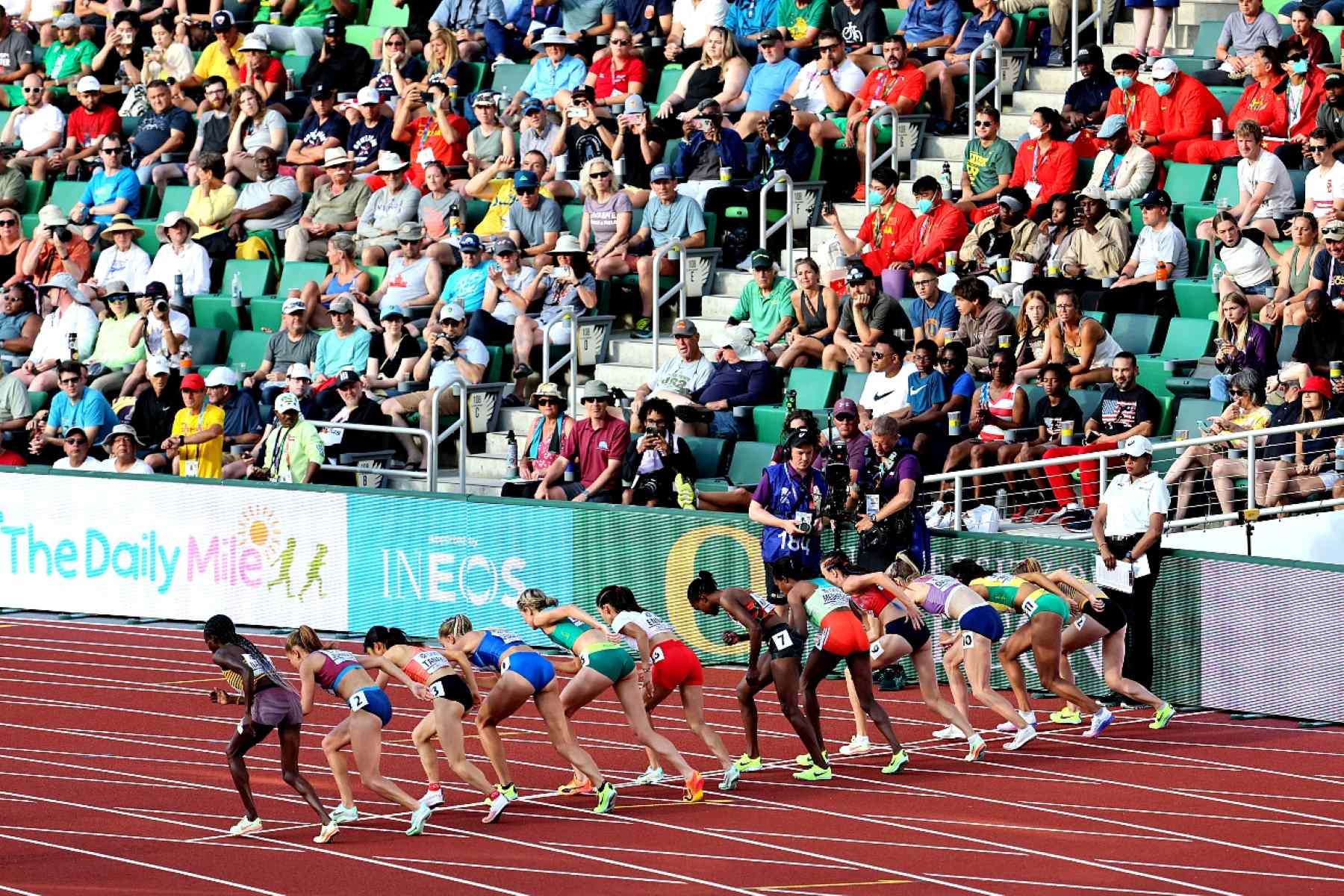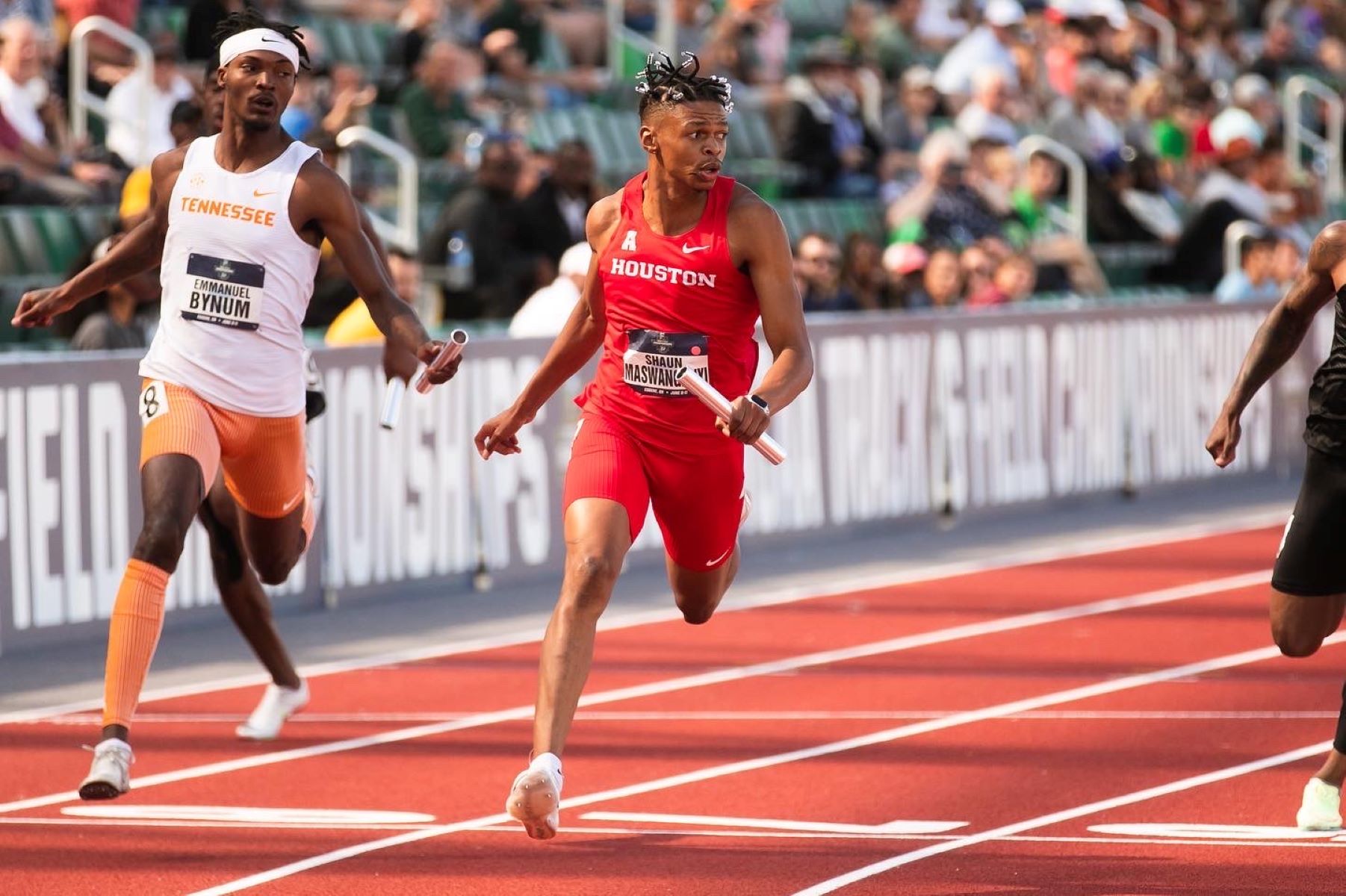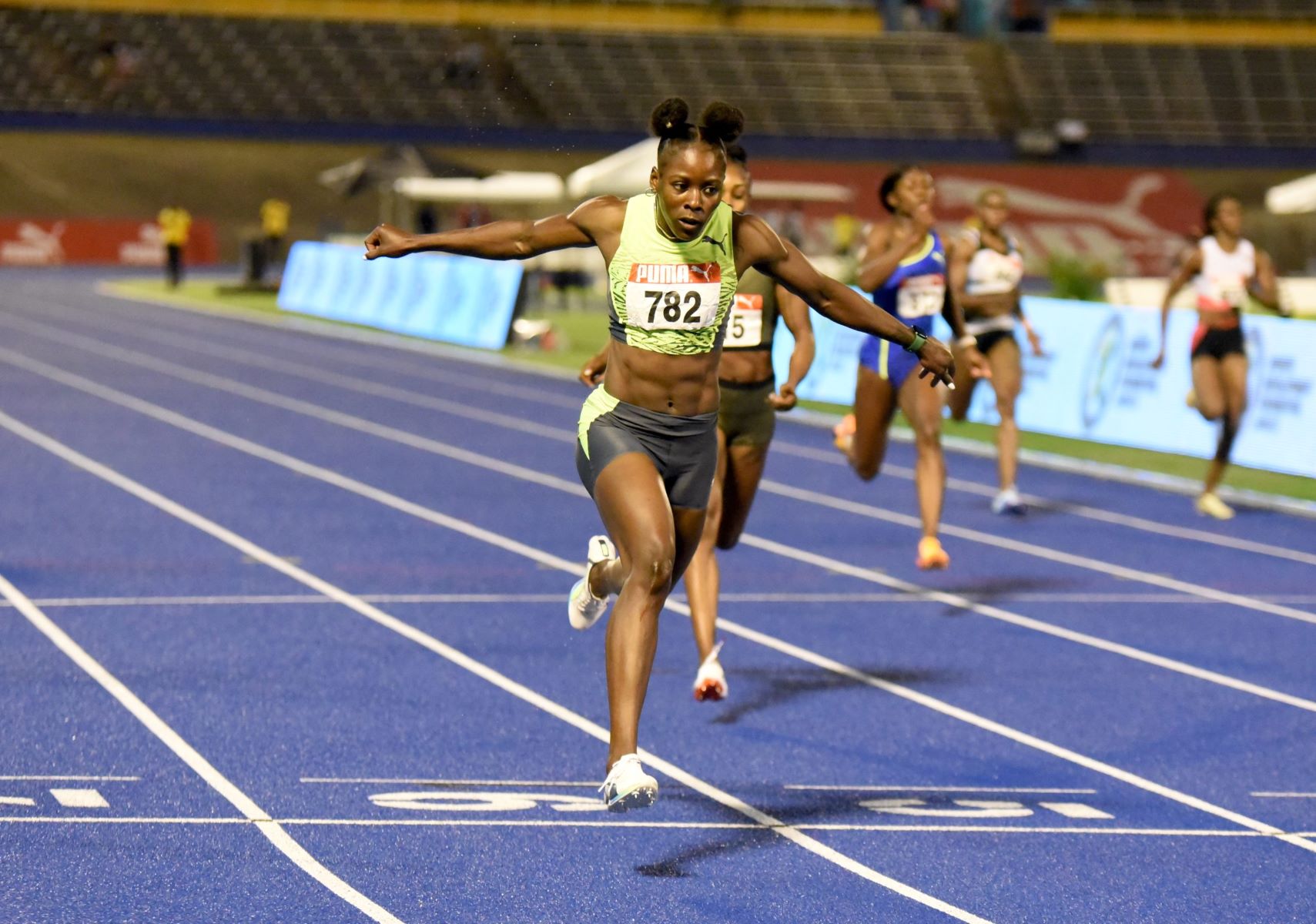

Featured
How To Be In Shape For Track And Field
Modified: January 2, 2024
Get featured in track and field by following these effective tips on how to be in shape. Maximize your potential with proven training techniques and nutrition advice.
Introduction
Track and field is a sport that requires a unique combination of speed, endurance, strength, and agility. To excel in this demanding sport, athletes must be in prime physical condition. Whether you are a sprinter, a long-distance runner, or a field event athlete, being in shape is crucial to performing at your best and achieving your goals.
Being in shape for track and field goes beyond simply having good cardiovascular fitness. It involves developing specific physical attributes that are essential for success in your chosen events. This includes building endurance to sustain performance over long distances, developing strength to generate power and explosiveness, and honing agility to maneuver quickly and efficiently.
In this article, we will explore the importance of being in shape for track and field and provide you with valuable tips on how to achieve and maintain your peak physical condition. We will delve into the key components of track and field fitness training, including endurance, strength, speed, agility, and plyometrics. Additionally, we will discuss the crucial role of nutrition, hydration, injury prevention, and mental preparation in enhancing your performance on the track.
By following the guidance provided in this article, you will be equipped with the knowledge and tools necessary to optimize your track and field fitness. Whether you are a seasoned athlete striving for a new personal best or a beginner looking to improve your athletic performance, this article will serve as a comprehensive resource to help you reach your goals. So, let’s dive in and discover how to be in shape for track and field!
Importance of Being in Shape for Track and Field
Being in shape for track and field is not just an added bonus; it is a fundamental requirement for success in the sport. The physical demands of track and field events necessitate athletes to be in peak condition in order to perform at their best. Here are some key reasons why being in shape is crucial for track and field athletes:
- Performance Enhancement: Being in shape significantly improves an athlete’s performance on the track. When the body is conditioned and in good physical shape, athletes experience increased energy levels, greater speed, and improved endurance. This allows them to push their limits and achieve better results in their events.
- Injury Prevention: One of the major benefits of being in shape is a reduced risk of injury. Track and field is a high-impact sport that puts a lot of stress on the body. By maintaining good physical fitness and strength, athletes can build robust muscles and joints, which act as protective mechanisms against injuries.
- Mental Confidence: Physical fitness plays a vital role in mental well-being and confidence. When athletes are in shape, they feel more confident in their abilities and are better equipped to handle the mental challenges that come with competitive sports. This confidence can make a significant difference in their overall performance on the track.
- Consistency and Progression: Track and field is a sport that requires consistent training and progression. By being in shape, athletes can ensure that their training efforts are maximized and that they can continually improve their performance over time. This consistency and progression are crucial for reaching long-term goals.
To reap these benefits, track and field athletes must prioritize their fitness and dedicate time and effort to achieve and maintain their optimal physical condition. It is important to note that being in shape is not just about physical appearance, but rather about being functionally fit and capable of meeting the specific demands of your chosen events.
In the next sections, we will explore the various components of track and field fitness training that can help athletes develop the necessary physical attributes for success. From endurance and strength training to speed and agility exercises, we will provide practical tips and guidelines to help you improve your track and field performance. So, let’s jump right into it and discover how you can be in shape for track and field!
Setting Goals for Track and Field Fitness
Setting goals is an essential aspect of track and field fitness. By setting clear and realistic goals, athletes can stay motivated, measure progress, and ultimately achieve their desired level of physical fitness. Here are some key steps to help you set effective goals for your track and field fitness journey:
- Identify Your Objectives: Begin by identifying what you want to achieve with your track and field fitness. Do you want to improve your speed, increase your endurance, or enhance your strength? Be specific about your objectives so that you can tailor your training program accordingly.
- Set SMART Goals: SMART stands for Specific, Measurable, Achievable, Relevant, and Time-bound. Ensure that your goals meet these criteria. For example, instead of setting a vague goal like “improve speed,” set a specific goal like “reduce 100-meter sprint time by 0.5 seconds within 3 months.”
- Break Down Your Goals: Big goals can be overwhelming, so break them down into smaller, achievable milestones. This not only makes them more manageable but also allows you to track progress more effectively. For example, if your main goal is to increase your endurance, set smaller goals like running an extra mile each week or completing a 10K race within a specific time frame.
- Write Them Down: Write down your goals and keep them visible. This serves as a constant reminder and helps you stay committed. Place them somewhere you can see them daily, such as on your bedroom wall or on your training log.
- Create a Plan: Once you have defined your goals, create a detailed plan to achieve them. This should include your training schedule, specific exercises, rest days, and any additional measures you need to take, such as adjusting your diet or incorporating cross-training activities.
- Track Your Progress: Regularly monitor and track your progress towards your goals. This can be done through performance metrics like measuring your race times, tracking your distance or repetitions, or even by using performance tracking apps or devices. Tracking your progress allows you to see how far you’ve come and make adjustments to your training program as needed.
- Stay Flexible: It’s important to remain flexible with your goals as circumstances may change. Adjustments and adaptations may be necessary along the way. Be open to revising your goals if needed, but always keep your ultimate objectives in mind.
Remember, setting goals is not just about the end result, but also about the journey. Embrace the process of working towards your goals and celebrate the small victories along the way. The sense of accomplishment from achieving each milestone will fuel your motivation and keep you on track to achieving your ultimate track and field fitness goals.
Proper Warm-up and Stretching Techniques
A proper warm-up is essential before any track and field workout or competition. It helps prepare your body for the physical demands of the activity, increases circulation, and loosens up your muscles and joints. Additionally, incorporating stretching techniques into your warm-up routine can improve your flexibility and prevent potential injuries. Here are some key tips for a proper warm-up and effective stretching techniques:
- Start with Dynamic Movements: Begin your warm-up with dynamic movements that mimic the actions you will be performing during your track and field activity. This could include exercises like high knees, butt kicks, leg swings, arm circles, or jumping jacks. Dynamic movements help increase your heart rate, warm up your muscles, and mobilize your joints.
- Incorporate Light Cardiovascular Exercise: Engage in light cardiovascular exercise, such as jogging or cycling, to further elevate your heart rate and increase blood flow to your muscles. This helps activate your aerobic system and prepares your body for more intense physical activity.
- Perform Sport-Specific Warm-up Exercises: Include warm-up exercises specific to your track and field event. For sprinters, this could involve performing a few short sprints or accelerations. If you are a high jumper, you could do a series of low-intensity jumps. Tailor your warm-up exercises to mimic the movements and intensity of your specific event.
- Transition to Static Stretches: After completing your dynamic warm-up, move on to static stretching exercises. Static stretches involve holding a stretch for 15-30 seconds to lengthen your muscles and improve flexibility. Focus on stretching the major muscle groups used in your event, such as your hamstrings, quadriceps, calves, and hip flexors.
- Avoid Bouncing or Jerking Movements: When performing static stretches, avoid bouncing or jerking movements, as these can potentially lead to muscle strains or injuries. Move slowly and gently into each stretch, and if you feel any discomfort or pain, ease off the stretch.
- Pay Attention to Your Breathing: Take deep breaths during your warm-up and stretches to help oxygenate your muscles and relax your body. Exhale as you deepen into each stretch, and inhale as you release the stretch.
- Don’t Skip Cool-Down and Mobility Work: After completing your track and field workout or competition, take the time to cool down and perform mobility exercises. This helps your body transition from intense activity to a resting state and promotes recovery. Cool-down activities can include a light jog, gentle stretching, or foam rolling to release any tension or tightness in your muscles.
Remember, a proper warm-up and stretching routine is vital for injury prevention and optimal performance in track and field. By incorporating these techniques into your training regimen, you can help prevent muscle imbalances, improve flexibility, and enhance your overall athletic performance.
Key Components of Track and Field Fitness Training
Track and field is a multi-faceted sport that requires a well-rounded approach to fitness training. To excel in your chosen events, it is essential to focus on key components that enhance your athletic performance. Here are the key components of track and field fitness training:
- Endurance: Endurance is crucial for track and field athletes, as it allows you to sustain your performance over long distances and periods of time. To build endurance, incorporate activities like long-distance running, tempo runs, interval training, and cross-training activities such as swimming or cycling into your training routine.
- Strength: Strength is essential for generating power and explosiveness in track and field events. Include strength training exercises that target the major muscle groups used in your events, such as squats, lunges, deadlifts, and plyometric exercises. Additionally, focus on core strength exercises to improve stability and overall athletic performance.
- Speed: Speed is crucial for sprinters and short-distance events. To improve your speed, incorporate interval training, sprint drills, and plyometric exercises that focus on explosive power and quick movements. Running uphill or on inclined surfaces can also help develop speed and leg power.
- Agility and Plyometrics: Agility refers to the ability to change direction quickly and efficiently. Incorporate agility drills, such as ladder drills, cone drills, and shuttle runs, into your training routine. Plyometric exercises, like box jumps, bounding, and depth jumps, can also improve your explosive power and enhance your overall athletic performance.
- Flexibility: Flexibility plays a significant role in preventing injuries and ensuring proper range of motion in track and field events. Incorporate regular stretching exercises, yoga sessions, and mobility work to improve flexibility and maintain optimal muscle balance throughout your body.
It is important to note that while these components are essential for track and field fitness training, the emphasis on each component will vary depending on your specific event. For example, a sprinter may focus more on speed and explosive power, while a long-distance runner may prioritize endurance and aerobic capacity.
To create a well-rounded training program, it is recommended to work with a coach or sports professional who can assess your individual needs and develop a tailored training plan that incorporates the key components mentioned above. Remember to gradually increase the intensity and volume of your training to avoid overexertion and injury.
By focusing on these key components of track and field fitness training, you can optimize your athletic performance, improve your results, and reach your full potential in your chosen events.
Endurance Training for Track and Field
Endurance is a crucial component of track and field fitness, especially for long-distance runners and middle-distance athletes. Endurance training allows athletes to perform at their peak for extended periods, improve aerobic capacity, and increase their ability to sustain a high level of effort. Here are some key tips for effective endurance training in track and field:
- Long-Distance Runs: Include regular long-distance runs in your training program to build endurance. Start with a comfortable distance and gradually increase the distance over time. Aim to maintain a steady pace throughout the run, focusing on building your aerobic capacity.
- Interval Training: Interval training involves alternating between periods of high-intensity effort and periods of active recovery. Incorporate interval training sessions into your weekly routine to improve both aerobic and anaerobic endurance. For example, perform repetitions of fast-paced running, followed by short recovery periods.
- Tempo Runs: Tempo runs involve running at a challenging pace that is slightly below your maximum effort. This type of training helps improve lactate threshold, which is the point at which lactic acid starts to accumulate in your muscles. Tempo runs should be challenging but sustainable for longer distances.
- High-Intensity Interval Training (HIIT): HIIT workouts involve short bursts of intense activity followed by short recovery periods. This type of training can be beneficial for improving both cardiovascular fitness and endurance. Incorporate exercises like sprints, hill repeats, or circuit training into your routine.
- Cross-Training Activities: Engaging in cross-training activities can help improve endurance and provide a break from repetitive running. Include activities like cycling, swimming, or rowing to give your running muscles a break while still working your aerobic system. This also helps prevent overuse injuries.
- Progressive Overload: Gradually increase the duration, distance, or intensity of your workouts to continually challenge your endurance. Avoid sudden increases in training load, as this can lead to injury or burnout. Maintain a balance between pushing yourself and allowing adequate recovery time.
It’s important to note that endurance training should be combined with proper nutrition and hydration to support your body’s energy needs. Ensure you are consuming a balanced diet that includes carbohydrates, protein, and healthy fats. Stay hydrated before, during, and after your workouts to optimize performance and recovery.
Remember to listen to your body and adjust your training as needed. Rest and recovery are just as important as training itself. Incorporate rest days into your training schedule to allow your body to recover and adapt to the demands of endurance training.
By incorporating these endurance training strategies into your track and field fitness routine, you will enhance your aerobic capacity, improve your performance, and be better prepared to compete in your chosen events.
Strength Training for Track and Field
Strength training is a crucial component of track and field fitness, as it helps athletes develop the power, explosiveness, and overall muscular strength necessary for success in their events. By incorporating strength training exercises into your training regimen, you can improve your performance, prevent injuries, and enhance your overall athletic ability. Here are some key tips for effective strength training for track and field:
- Focus on Compound Exercises: Compound exercises target multiple muscle groups and joints simultaneously. These exercises are highly beneficial for track and field athletes as they promote overall strength and functional movement. Some examples include squats, deadlifts, lunges, bench presses, and overhead presses.
- Include Plyometric Exercises: Plyometric exercises involve quickly stretching and contracting muscles to generate power and explosiveness. These exercises can enhance your speed, agility, and overall athletic performance. Examples of plyometric exercises include box jumps, depth jumps, and explosive jumps.
- Train for Sport-Specific Movements: Identify the specific movements required for your track and field event and incorporate exercises that mimic those movements. For example, if you are a shot put thrower, focus on exercises that target the muscles involved in the throwing motion, such as medicine ball throws and rotational exercises.
- Don’t Neglect Core Strength: Core strength is essential for stability, balance, and force transfer in track and field events. Include exercises that target your core muscles, such as planks, Russian twists, and woodchoppers. A strong core will benefit all aspects of your athletic performance.
- Vary Intensity and Repetitions: Vary the intensity and repetitions in your strength training workouts. This will help develop different types of strength, including maximal strength, muscular endurance, and power. Incorporate heavier weights with lower repetitions for maximal strength and lighter weights with higher repetitions for muscular endurance.
- Proper Form and Technique: Focus on maintaining proper form and technique throughout your strength training exercises. This will maximize the effectiveness of the exercise and reduce the risk of injuries. If you are unsure about the correct form, consider working with a qualified strength training coach.
- Balance Strength Training with Other Training Components: While strength training is important, it should be balanced with other components of track and field fitness training, such as endurance, speed, and agility. Make sure to allocate sufficient time for each element in your training program.
Allow adequate rest and recovery between strength training sessions to allow your muscles to repair and adapt. This will help prevent overtraining and reduce the risk of overuse injuries. Additionally, ensure you fuel your body properly with a balanced diet that includes enough protein for muscle repair and growth.
By incorporating these strength training principles into your track and field training program, you will improve your overall physical strength, power, and athletic performance. Remember to gradually progress your training load and always prioritize proper form and technique to maximize your gains and minimize the risk of injury.
Speed Training for Track and Field
Speed is a crucial component of track and field performance, especially for sprinters and short-distance events. Speed training focuses on improving an athlete’s ability to generate maximal velocity, quick acceleration, and efficient sprinting technique. By incorporating speed training into your track and field regimen, you can enhance your sprinting speed and overall athletic performance. Here are some key tips for effective speed training:
- Sprint Drills: Incorporate sprint drills into your training routine to improve your sprinting technique and form. These drills include high knees, butt kicks, A-skips, B-skips, and strides. Focus on driving your knees forward, maintaining a tall posture, and a strong arm drive.
- Interval Training with Sprints: Integrate interval training sessions with sprints into your training plan. This involves alternating periods of high-intensity sprinting with periods of active recovery. For example, perform all-out sprints for a specific distance or time, followed by a light jog or walk to recover before the next sprint. Gradually increase the intensity and duration of your sprints as you progress.
- Hill Sprints: Incorporate hill sprints into your training routine. Running uphill challenges your muscles more than running on a flat surface, helping to develop strength and power. Find a suitable hill with a gradual incline and perform sprints up the hill. Focus on explosive movements and maintaining proper sprinting form while tackling the incline.
- Resistance Training: Include resistance training exercises specific to sprinting, such as sled pushes or pulls, weighted sled sprints, or parachute sprints. These exercises create added resistance that strengthens your muscles, improves power development, and enhances stride efficiency.
- Maximal Velocity Training: To improve your maximum sprinting velocity, incorporate drills that focus on maintaining high speeds. Interval training with longer sprints at maximum effort and adequate recovery allows you to train your body to sustain top-end speeds and improve your anaerobic capacity.
- Plyometric Exercises: Plyometric exercises, such as bounding, box jumps, and depth jumps, can enhance your explosiveness and power for sprinting. These exercises train your muscles to rapidly stretch and contract, which improves your ability to generate force and improve your stride length and frequency.
It’s important to note that speed training should be balanced with appropriate rest and recovery. Sprinting at high intensities places significant stress on your muscles and can increase the risk of injury if not managed properly. Allow for adequate rest periods between speed training sessions to allow your body to recover and adapt.
Incorporating speed training into your track and field regimen will help you develop the necessary speed and power to excel in your events. Remember to gradually progress your training load and always prioritize proper form, technique, and injury prevention to maximize your speed gains and minimize the risk of injuries on the track.
Agility and Plyometric Training for Track and Field
Agility and plyometric training are essential components of track and field fitness, as they help athletes improve their explosiveness, quickness, and ability to change direction efficiently. Incorporating agility and plyometric exercises into your training regimen can greatly enhance your performance in sprinting, jumping, and other track and field events. Here are some key tips for effective agility and plyometric training:
- Agility Drills: Incorporate agility drills into your training routine to improve your ability to change direction quickly and efficiently. These drills can include ladder drills, cone drills, shuttle runs, and agility ladder exercises. Focus on quick footwork, maintaining good body control, and fluid movements.
- Change-of-Direction Exercises: Perform exercises that require sudden changes of direction, such as zig-zags, lateral shuffles, and figure-8 runs. These exercises simulate the directional changes you’ll encounter during competition and enhance your ability to react and adjust rapidly.
- Plyometric Exercises: Plyometric exercises involve quick, explosive movements that train your muscles to rapidly stretch and contract. Incorporate exercises such as box jumps, depth jumps, bounding, and single-leg hops. These exercises improve your power output, explosiveness, and overall athletic performance.
- Progressive Plyometric Training: Start with basic plyometric exercises and gradually progress to more advanced drills as your body becomes accustomed to the demands. Ensure you have a solid foundation of strength and coordination before attempting more complex plyometric movements. Focus on quality over quantity, maintaining proper form and technique throughout.
- Balance and Coordination: Incorporate exercises that challenge your balance and coordination, such as single-leg exercises and unstable surface training. These exercises strengthen the muscles responsible for stabilizing your joints and improve your overall body control and proprioception.
- Combine Agility and Plyometrics: Integrate agility and plyometric exercises for a more comprehensive training effect. For example, perform a series of agility ladder drills followed by a set of depth jumps or box jumps. This combination will enhance your explosiveness, agility, and coordination.
It’s important to warm up properly and gradually increase the intensity of your agility and plyometric training to reduce the risk of injuries. Maintain proper form throughout exercises, paying attention to landing mechanics and ensuring your muscles are properly engaged and aligned.
As with any training modality, proper rest and recovery are crucial. Allow for adequate recovery time between agility and plyometric training sessions to allow your body to adapt and minimize the risk of overuse injuries.
By incorporating agility and plyometric training into your track and field regimen, you will develop the explosive power, quickness, and reactive capabilities necessary for success in your events. Remember to start with a solid foundation, progress gradually, and always prioritize proper form and injury prevention to maximize your performance on the track.
Nutrition and Hydration Tips for Track and Field Athletes
Proper nutrition and hydration are crucial for track and field athletes to fuel their performance, support recovery, and maintain overall health. The right balance of nutrients and hydration can enhance performance, reduce fatigue, and help prevent injuries. Here are some key tips for nutrition and hydration for track and field athletes:
- Stay Hydrated: Hydration is essential for optimal performance and overall health. Drink water throughout the day, especially before, during, and after training sessions or competitions. Aim for a minimum of 8-10 cups (64-80 ounces) of water per day, or more if you are sweating heavily.
- Carbohydrates for Energy: Carbohydrates are the primary fuel source for track and field athletes. Include complex carbohydrates in your diet, such as whole grains, fruits, vegetables, and legumes. These foods provide sustained energy and help replenish glycogen stores in your muscles.
- Protein for Muscle Repair: Protein is important for muscle repair and growth. Include lean sources of protein in your diet, such as poultry, fish, lean meat, eggs, dairy products, and plant-based protein sources like tofu, beans, and lentils. Aim to consume protein-rich foods at each meal and snack.
- Timing of Meals and Snacks: Fuel your body by consuming balanced meals and snacks throughout the day. Eat a meal or snack containing carbohydrates and protein within two hours before your training or competition. Refuel with a carbohydrate and protein-rich snack within 30 minutes to an hour after your workout to aid in muscle recovery.
- Micronutrients: Ensure you are getting an adequate intake of vitamins and minerals to support your overall health and performance. Include a variety of fruits, vegetables, nuts, and seeds in your diet to obtain a wide range of micronutrients.
- Avoid Excessive Sugar and Processed Foods: Limit your intake of sugary drinks, candies, and processed foods as they provide empty calories and can lead to energy crashes and nutrient deficiencies. Opt for whole, nutrient-dense foods that provide sustained energy and support your overall health.
- Pre-Competition Meal: Eat a balanced meal that includes easily digestible carbohydrates, lean protein, and a moderate amount of healthy fats, about 2-3 hours before your competition. This will provide you with sustained energy without causing gastrointestinal discomfort during your event.
- Post-Competition Recovery: After a competition or intense training session, prioritize replenishing your glycogen stores and aiding muscle recovery by consuming a post-workout snack or meal containing carbohydrates and protein.
Remember to listen to your body’s individual needs and consult with a sports nutritionist or registered dietitian for personalized advice. Every athlete is unique and may require specific adjustments and considerations based on their training volume, body composition, and dietary preferences.
By fueling your body with the right nutrients and staying properly hydrated, you can optimize your performance, facilitate recovery, and achieve your full potential in track and field.
Injury Prevention and Recovery Strategies for Track and Field
In track and field, like any other sport, injuries can occur due to the repetitive nature and high-intensity demands of training and competing. However, with proper injury prevention strategies and effective recovery practices, track and field athletes can minimize the risk of injuries and optimize their performance. Here are some key tips for injury prevention and recovery in track and field:
- Proper Warm-up and Cool-down: Start each training session or competition with a thorough warm-up to prepare your body for activity. This should include dynamic movements, light cardio, and sport-specific drills. Similarly, cool down after your workouts with a gentle jog or light stretching to help your muscles recover.
- Gradual Progression: Gradually increase the intensity, volume, and duration of your training to allow your body to adapt and reduce the risk of overuse injuries. Avoid sudden spikes in training load and listen to your body’s signals of fatigue or pain.
- Strength and Conditioning: Include strength training exercises in your program to strengthen muscles, tendons, and ligaments, reducing the risk of injuries. Focus on exercises that target the muscles specific to your event and those that provide overall strength and stability, such as core workouts.
- Flexibility and Mobility: Incorporate regular stretching and mobility exercises to improve joint range of motion and prevent muscle imbalances. Pay attention to areas commonly prone to injuries in your event and develop a stretching routine that targets those specific areas.
- Proper Technique: Ensure you are using correct form and technique during training and competition. Improper technique can place excessive stress on joints and muscles, increasing the risk of injury. Seek guidance from coaches or experienced athletes to refine your technique.
- Listen to Your Body: Pay attention to any warning signs or signals that your body may be giving you. If you experience persistent pain or discomfort, it’s important not to ignore it. Rest and seek the advice of a healthcare professional to address the issue before it worsens.
- Rest and Recovery: Adequate rest and recovery are essential for injury prevention. Include scheduled rest days in your training program to allow your body to repair and recharge. Additionally, prioritize getting enough quality sleep to promote proper recovery and reduce the risk of injury.
- Cross-Training and Variation: Engage in cross-training activities and vary your training routine to avoid overuse injuries and promote overall fitness. Incorporate activities such as swimming, cycling, or yoga to provide different movement patterns and reduce the repetitive stress on your body.
In the event of an injury, it’s important to seek proper medical attention. Follow the guidance of healthcare professionals, such as physiotherapists or sports medicine specialists, for an appropriate treatment plan tailored to your specific injury.
By implementing these injury prevention and recovery strategies, you can reduce the risk of injuries and maintain a healthy and consistent training program. Prioritizing injury prevention and taking proactive measures to recover will contribute to your long-term success in track and field.
Rest and Sleep for Optimal Track and Field Performance
Rest and sleep are often overlooked but critical components of track and field performance. Proper rest and adequate sleep play a vital role in the recovery process, injury prevention, and overall athletic performance. Here are some key considerations for incorporating rest and sleep into your track and field training routine:
- Scheduled Rest Days: Incorporate scheduled rest days into your training program. These days allow your body to recover from the physical stresses of training and reduce the risk of overuse injuries. Rest days can also help prevent mental burnout and maintain a healthy balance between training and recovery.
- Listen to Your Body: Pay attention to your body’s signals and cues for rest. If you’re feeling excessively fatigued, experiencing persistent muscle soreness, or lacking motivation, it may be a sign that you need additional rest. Give yourself permission to take extra rest days as needed.
- Proper Sleep Duration: Aim for a consistent and adequate amount of sleep each night. Most adults require between 7-9 hours of uninterrupted sleep for optimal performance and recovery. Sleep allows your body to repair and regenerate tissues, strengthen the immune system, and improve cognitive function.
- Sleep Quality: In addition to sleep duration, prioritize sleep quality. Create a conducive sleep environment that is cool, dark, and quiet. Establish a consistent bedtime routine to signal to your body that it’s time to relax and prepare for sleep. Minimize exposure to electronic devices and stimulating activities before bed as they can interfere with sleep quality.
- Napping: Incorporate short power naps into your routine, especially on days of intense training or when you’re feeling fatigued. Naps of 20-30 minutes can provide a quick boost in alertness and cognitive function, improving your overall performance during training sessions or competitions.
- Recovery Techniques: In addition to sleep, explore different recovery techniques such as foam rolling, stretching, massage, or cold-water immersion to facilitate muscle recovery and relaxation. These techniques can help reduce muscle soreness, increase flexibility, and enhance overall recovery between training sessions.
- Stress Management: Managing stress is crucial for restful sleep and optimal performance. Incorporate stress management techniques such as deep breathing exercises, meditation, or journaling into your daily routine. Find activities outside of track and field that help you unwind and relax, promoting a restful state of mind.
Remember that rest and sleep are not signs of weakness but essential elements of your training program. They allow your body to adapt, repair, and grow stronger. By prioritizing rest and sleep, you enhance your body’s resilience, reduce the risk of injuries, and optimize your overall track and field performance.
Mental Preparation and Motivation for Track and Field Competitions
Track and field competitions not only require physical prowess but also mental strength and focus. Mental preparation and motivation are crucial aspects of performance that can significantly impact your results on the track. Here are some key strategies to enhance your mental preparation and motivation for track and field competitions:
- Visualize Success: Use visualization techniques to mentally rehearse your competition. Visualize yourself executing the perfect race, performing at your best, and achieving your desired results. Imagine the sensations, sights, and sounds of the competition environment to create a realistic mental picture.
- Set Process Goals: Instead of solely focusing on outcome goals like winning, set process-oriented goals that are within your control. Examples may include maintaining proper form, executing race strategies, or hitting specific split times. Process goals help you stay present and focused on the task at hand.
- Positive Self-Talk: Use positive self-talk to build confidence and overcome challenges. Replace negative thoughts with positive and motivating affirmations. Remind yourself of your strengths, past successes, and the hard work and dedication you have put into your training.
- Create a Pre-Competition Routine: Develop a consistent pre-competition routine that includes activities that help you relax, focus, and get in the right mindset. This may involve listening to music, doing light stretching, or engaging in a specific warm-up routine. Your routine should be personalized to what helps you feel confident and mentally prepared.
- Manage Anxiety and Nervousness: It’s natural to feel nervous before a competition. Learn strategies to manage anxiety, such as deep breathing, progressive muscle relaxation, or meditation. Adopt a mindset where you view nerves as excitement and use the energy to enhance your performance rather than hinder it.
- Embrace Challenges: Embrace the challenges that come with track and field competitions. View setbacks or difficult races as learning opportunities and stepping stones toward improvement. Approach each competition with a growth mindset and see challenges as chances to push your limits and become a better athlete.
- Find Motivation: Understand your personal motivations for participating in track and field. Whether it’s to achieve personal goals, represent your team, or simply enjoy the sport, connect with what truly drives you. Find inspiration from within and external sources like watching elite athletes or reading motivating stories.
- Focus on the Process: Instead of fixating on the outcome or the end result, focus on the process. Direct your attention to the present moment, such as your technique, breathing, or strategy during the competition. By staying in the present, you can perform at your best without being distracted by future outcomes.
Remember, track and field competitions are not just physical battles but mental ones as well. Developing mental strength and using motivational strategies will help you perform at your best, overcome obstacles, and embrace the challenges that come with the sport. With the right mindset and mental preparation, you can maximize your potential and achieve your goals in track and field.
Conclusion
Track and field is a demanding and exhilarating sport that requires a combination of physical fitness, skill, and mental fortitude. By incorporating the key components of track and field fitness training, such as endurance, strength, speed, agility, and plyometrics, athletes can improve their performance and reach their full potential. Establishing clear goals, prioritizing rest and recovery, and implementing proper nutrition and hydration strategies are essential for success in track and field.
Additionally, injury prevention, mental preparation, and motivation play crucial roles in achieving optimal performance on the track. By utilizing injury prevention strategies and incorporating recovery techniques, athletes can maintain their well-being and continue to train and compete at a high level. Mental preparedness, visualization, positive self-talk, and finding personal motivation can significantly impact results on race day and help athletes overcome challenges.
As track and field athletes strive for excellence, it is important to maintain a balanced approach to training and listen to the body’s needs. Every athlete is unique, and finding what works best for you, whether it’s in terms of training methods, nutrition, or motivation, is key. By constantly striving for improvement, embracing challenges, and staying dedicated to the sport, track and field athletes can continuously grow and achieve their goals.
So, lace up your running shoes, unleash your inner strength, and embrace the journey of becoming the best track and field athlete you can be. With dedication, perseverance, and the right training strategies, you have the power to surpass your limits and excel in every aspect of track and field.









